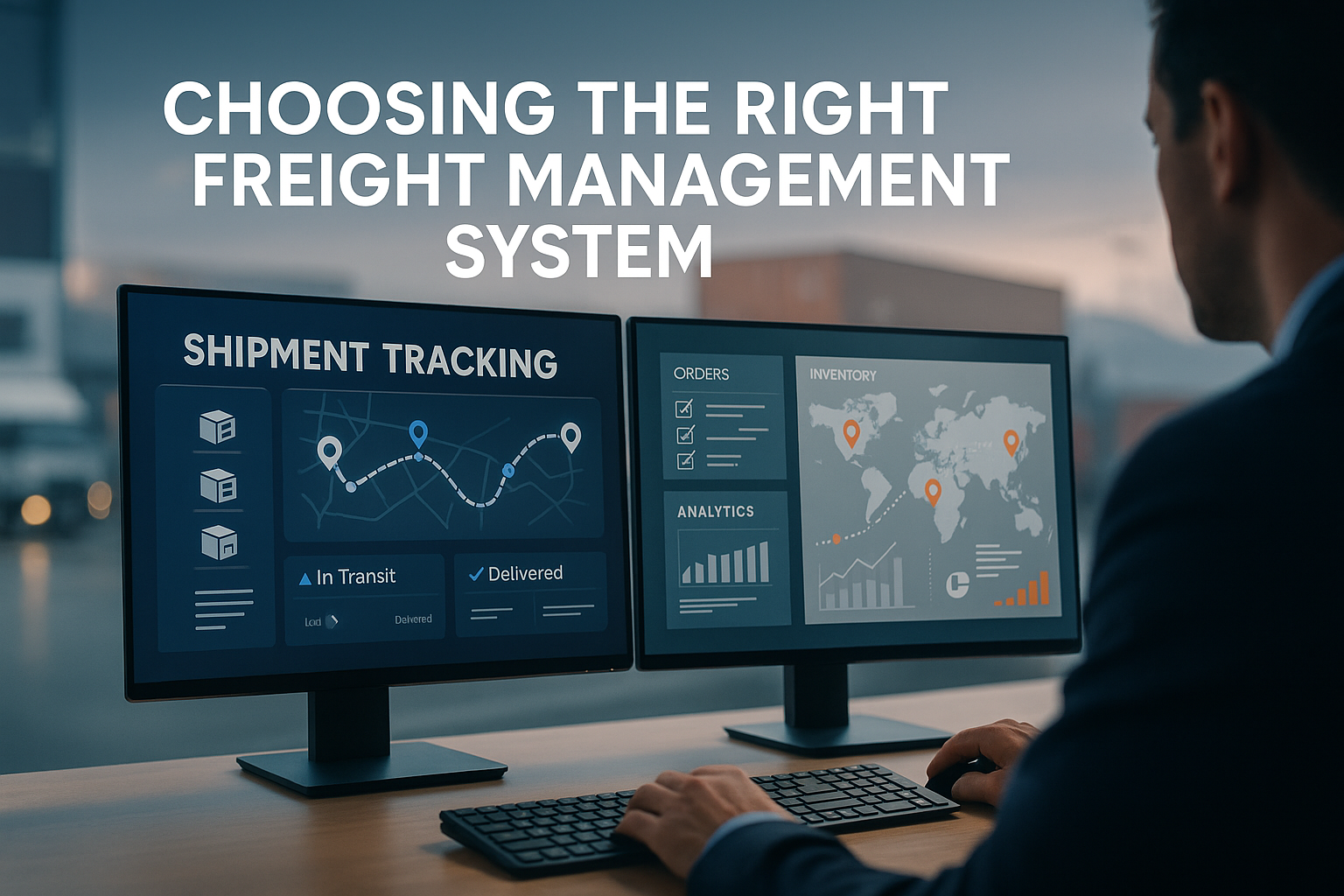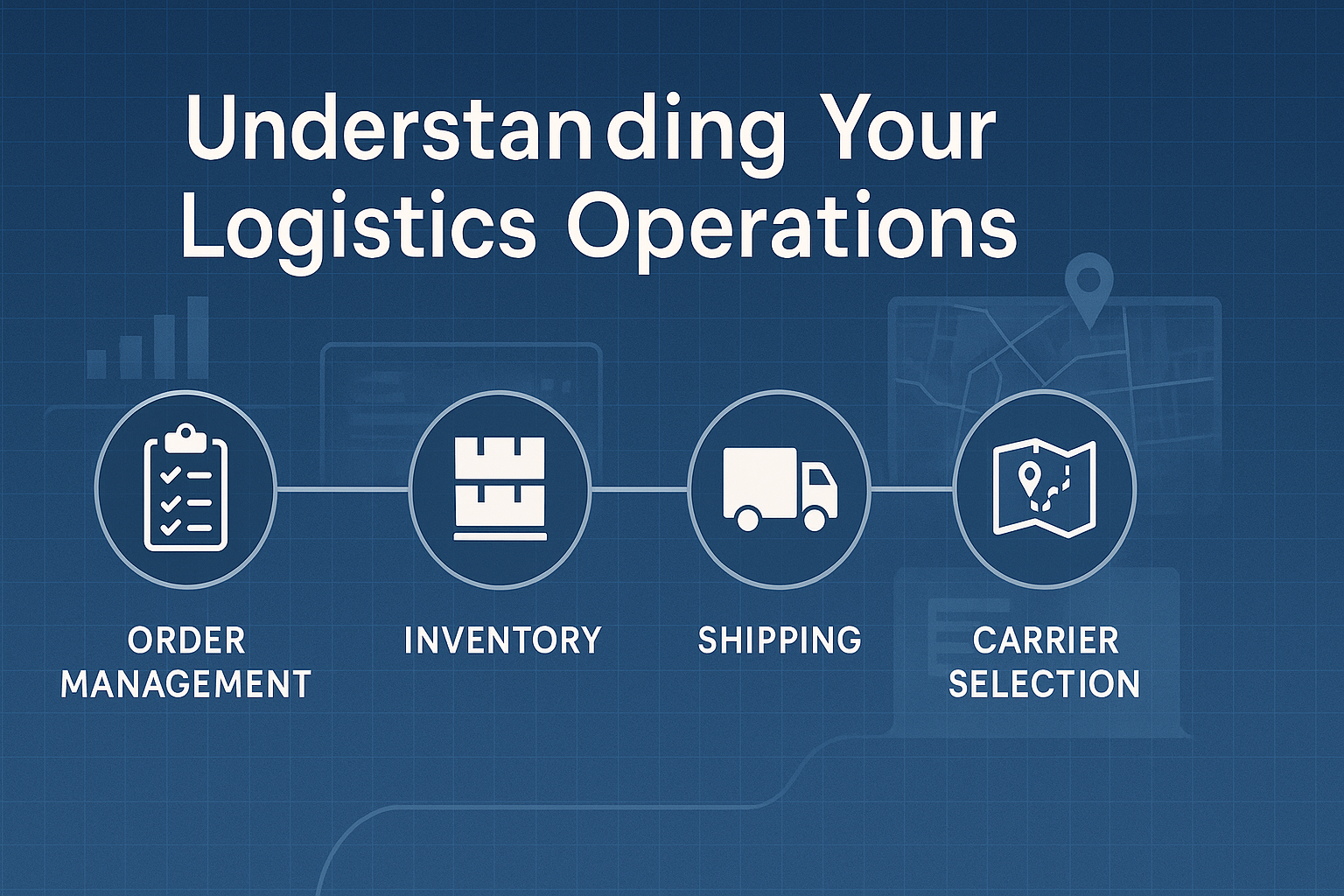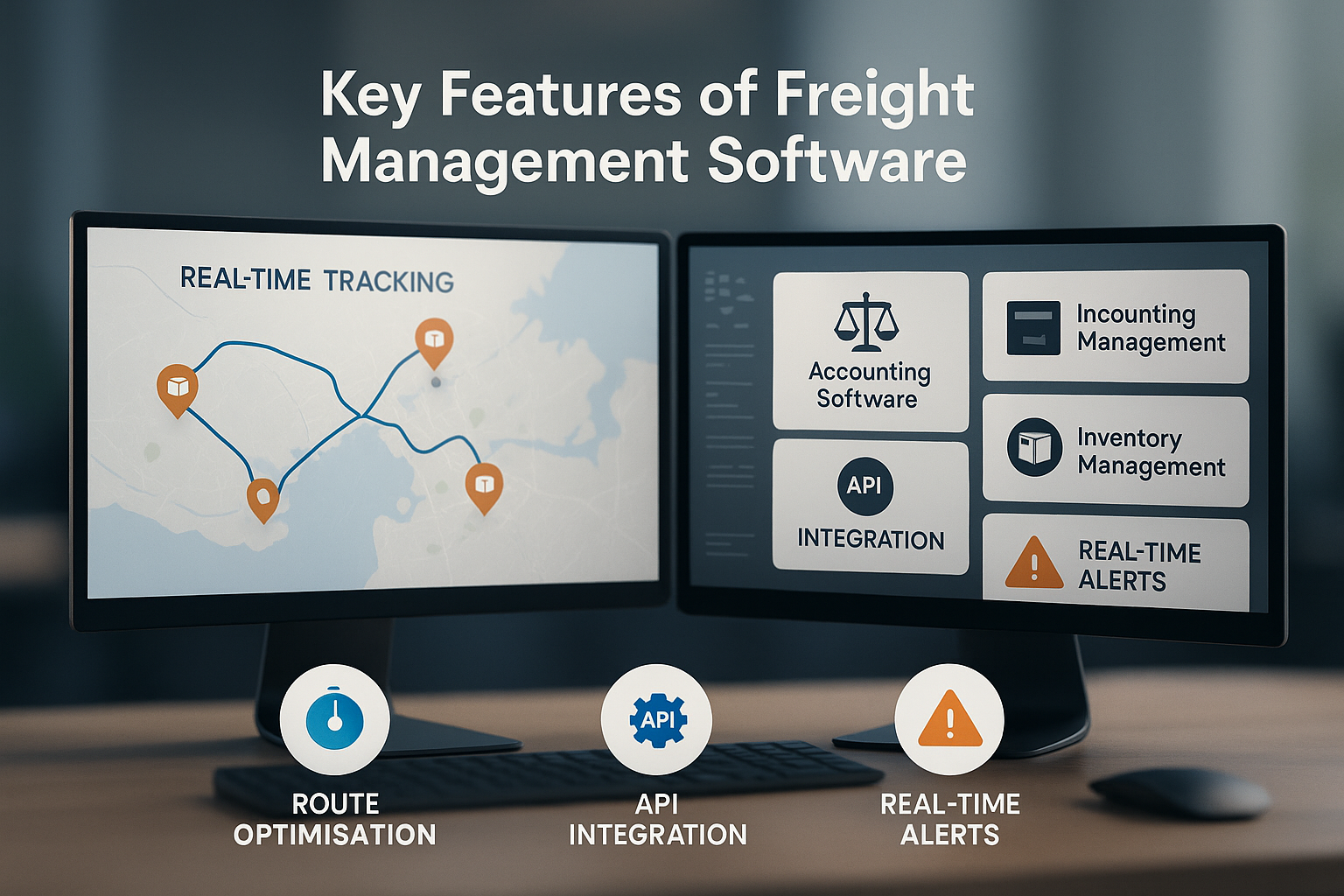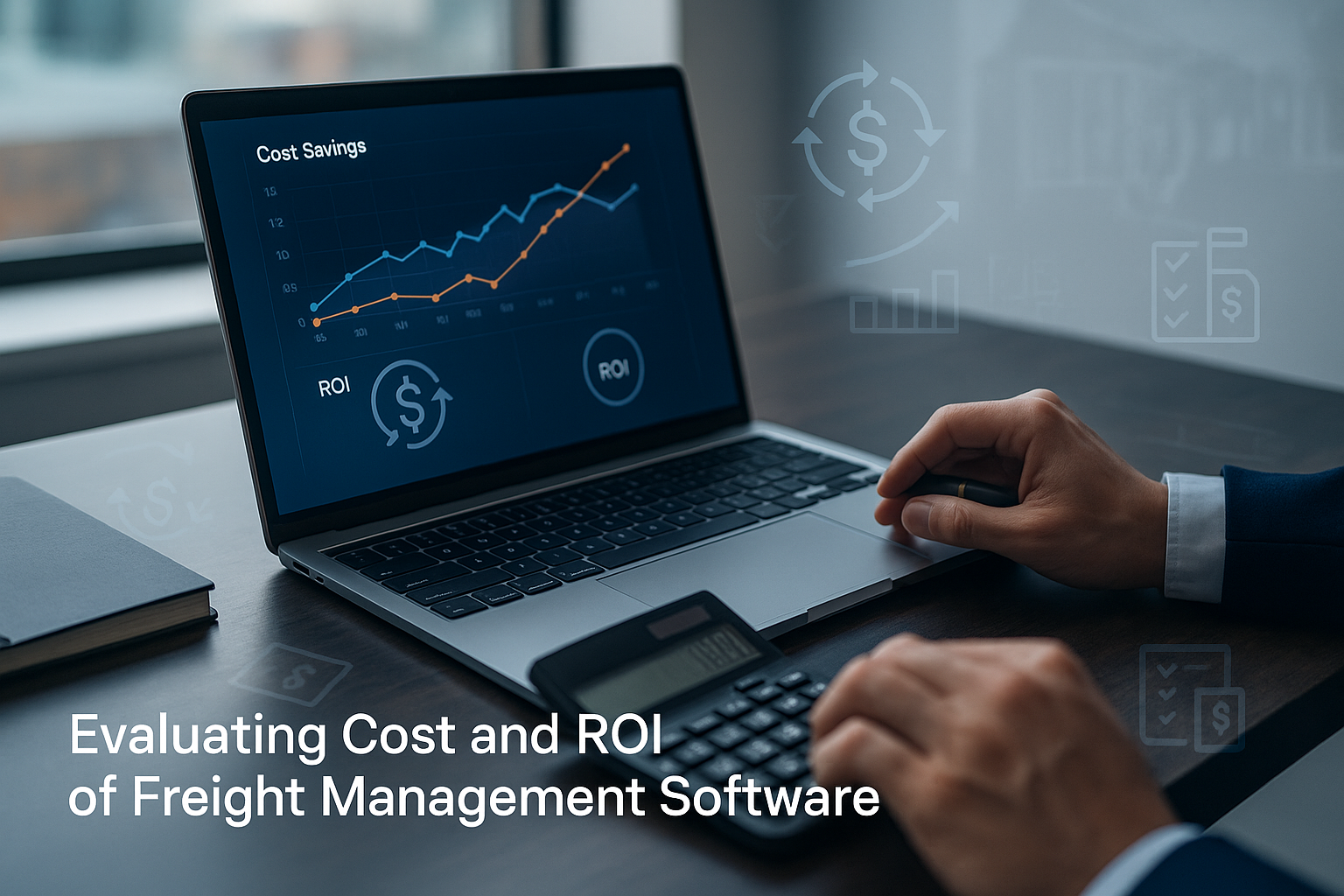Selecting the right freight forwarding software is essential for businesses striving to optimise their logistics operations and improve efficiency.
The right software can streamline processes, reduce costs, and enhance customer satisfaction by providing real-time shipment visibility and seamless integration with existing tools.
With numerous freight management software options on the market, this guide will help you understand how to choose the best freight management system for your business by exploring critical factors, features, and cost considerations.

Let's Get Straight to the Point
Choosing the right freight management system is essential for improving logistics operations, enhancing efficiency, and driving business growth.
Key steps include assessing your business size and challenges, ensuring real-time shipment tracking, and prioritising seamless integration with existing tools like accounting and inventory management systems.
While evaluating the total cost of ownership and return on investment (ROI), focus on scalability, security, and compliance. Consider advanced features like route optimisation and select software with a user-friendly interface and strong customer support.
A well-chosen system will streamline processes, improve freight operations, and meet future demands in the competitive logistics industry.
Understanding Your Business Needs
Understanding your business’s unique needs is the first step in selecting the right freight forwarding software.
A thorough evaluation of your current operations, challenges, and future goals ensures that the software meets your organisation’s requirements perfectly.
1. Assessing Your Business Size and Scope
The size and scope of your business heavily influence the complexity and type of freight management system you need.
Smaller businesses often benefit from straightforward software solutions with basic features like real-time tracking, shipment management, and shipment tracking. These tools focus on keeping operations simple and efficient without adding unnecessary costs.
Larger enterprises require robust, scalable transportation management systems (TMS solutions) that can handle multiple carriers, advanced route optimisation, and real-time shipment visibility across vast supply chain networks.
Understanding your business size and complexity ensures you select software that meets your current demands and supports future growth.
2. Identifying Key Challenges
Every business has unique pain points that a freight management system can address. Common challenges include:
Lack of real-time shipment tracking capabilities, leading to delays in managing customer expectations.
Inefficient manual data entry, which increases the risk of errors and slows down operations.
Integration gaps with existing systems, such as accounting software, inventory management tools, or supply chain management platforms.
By identifying these challenges, businesses can focus on finding software that resolves these specific issues, improving overall freight operations.
3. Considering Growth and Team Expertise
A forward-thinking approach is essential when choosing a freight management software.
Consider your business growth trajectory. Will the software remain useful as your shipment volumes increase or your business expands into new markets?
Evaluate your team’s technical expertise. Opting for a user-friendly interface reduces the need for extensive training and ensures quicker adoption.
Understanding Your Logistics Operations
Understanding your logistics operations is crucial in selecting the right freight management software. This step involves analysing your current processes, identifying areas for improvement, and determining your specific needs.
It helps you create a clear picture of your logistics operations and make informed decisions about choosing a software solution.

To understand your logistics operations, start by mapping out your current processes, including:
Order Management: How do you receive and process orders?
Inventory Management: How do you manage your inventory levels and track stock movements?
Shipment Planning: How do you plan and schedule shipments?
Transportation Management: How do you manage your transportation operations, including carrier selection and routing?
Freight Audit and Payment: How do you audit and pay freight invoices?
Identify areas for improvement, such as:
Inefficient manual processes
Lack of visibility into shipment status
Inaccurate inventory levels
High transportation costs
Difficulty in managing multiple carriers and modes of transportation
Determine your specific needs, including:
The type of freight you handle (e.g., parcel, LTL, TL, air, ocean)
The number of shipments you process per day/week/month
The number of carriers and modes of transportation you use
The level of automation you require
The need for integration with existing systems, such as accounting software or warehouse management systems
Understanding your logistics operations will help you identify your needs and make informed decisions about selecting a freight management software solution.
This comprehensive understanding ensures that the chosen software aligns perfectly with your operational requirements, enhancing overall efficiency and supporting business growth.
Key Features of Freight Management Software
To select the right freight forwarding software, you must evaluate its features and determine how they align with your operational requirements.

1. Real-Time Tracking and Visibility
Real-time tracking and shipment tracking visibility are among the most important features of any freight management system. These capabilities enable businesses to:
Monitor shipments at every stage of the shipping process.
Provide accurate updates to customers, enhancing customer satisfaction.
Improve efficiency by identifying and addressing delays immediately.
This functionality is especially beneficial for freight forwarders managing large volumes of shipments or navigating complex logistics and supply chains.
2. Seamless Integration with Existing Systems
A seamless integration with your existing systems ensures smooth workflows and minimises disruptions:
Linking with accounting software simplifies financial reporting and cost tracking.
Integrating with inventory management systems improves stock control and reduces discrepancies.
Integrating software ensures consistency across departments and enhances operational accuracy by enabling seamless data exchange.
3. Scalability and Flexibility
Scalability and flexibility are important features for businesses that anticipate change:
A scalable system accommodates increased shipment volumes, supporting business growth and adapting to new operational demands.
Flexible tools cater to specific requirements, such as handling multiple carriers or managing unique freight forwarding operations.
Choosing software that grows with your business prevents costly upgrades or replacements in the future.
4. Advanced Features for Complex Needs
Advanced features like route optimisation, real-time visibility, and data analytics give companies that handle intricate freight forwarding processes a competitive edge.
These tools enable businesses to:
Identify the most cost-effective shipping routes.
Analyse operational data to pinpoint inefficiencies.
Streamline complex logistics scenarios.
Evaluating Freight Management System Costs
Cost is a significant factor in choosing the right freight management software. It is important to understand the short-term and long-term financial implications.

1. Understanding the Total Cost of Ownership
The total cost of ownership includes more than just the purchase price:
Initial investment costs for the software itself.
Training resources required to onboard your team.
Ongoing maintenance, upgrades, and technical support.
Considering these elements ensures that businesses avoid hidden costs and assess the long-term affordability of the software.
2. Measuring ROI
A thorough return on investment (ROI) analysis helps businesses determine whether the software provides sufficient value:
Quantify savings from cost control through features like freight rate management and route optimisation.
Calculate productivity improvements resulting from reduced manual data entry and automated tasks.
Measure enhanced customer experiences stemming from real-time tracking and better communication.
Security and Compliance
A reliable freight management system must prioritise data security and regulatory compliance.
1. Ensuring Data Security
Businesses must safeguard sensitive information:
Choose software with robust encryption protocols to prevent cyber threats.
Verify that the software complies with global security standards to protect your data and operations.
2. Compliance with Regulations
Compliance with regulations, such as the General Data Protection Regulation (GDPR), is essential.
Ensuring the software adheres to these standards reduces legal risks and demonstrates a commitment to ethical business practices.
Reading Reviews and Seeking Recommendations
Reading reviews and seeking recommendations from industry peers and experts is essential in selecting the right freight management software. It helps you gain insights into the software’s performance, reliability, and user satisfaction.
When reading reviews, look for:
Overall rating and satisfaction level
Specific features and functionalities that are praised or criticised
Any common issues or complaints
The reviewer’s experience and expertise in the industry
Seek recommendations from:
Industry peers and colleagues who have experience with freight management software
Experts in the field, such as logistics consultants or industry analysts
Online forums and communities, such as LinkedIn groups or Reddit forums
Ask questions, such as:
What are the software’s strengths and weaknesses?
How easy is it to implement and use?
What level of support and training is provided?
How scalable is the software?
What are the total costs of ownership, including any hidden fees?
By reading reviews and seeking recommendations, you can gain a more comprehensive understanding of the software’s capabilities and make a more informed decision when selecting a freight management software solution.
This approach ensures that you choose a system that meets your current needs and supports your long-term business goals, enhancing operational efficiency and driving business growth.
Implementation and Support
Transitioning to a new freight management system requires careful planning to ensure minimal disruption and maximum benefits.
1. Onboarding and Training
Successful implementation hinges on providing comprehensive onboarding and training:
A user-friendly interface accelerates the learning curve, reducing the time and resources required for training.
Detailed documentation and tutorials support team members in mastering the system’s features.
2. Customer Support
Exceptional customer support is a critical component of any software provider’s offering:
Choose a vendor with a proven track record of resolving technical issues promptly.
Prioritise providers offering ongoing support, ensuring you can navigate challenges as they arise.
Choosing the Right Freight Management System
Selecting the right freight management system involves more than just evaluating features and costs. It requires aligning the software with your specific business needs.
1. Consider Your Business Needs
Begin by outlining your organisation’s key requirements:
What is the scale of your freight forwarding business?
Do you require integration with existing tools, such as logistics software or inventory management systems?
Are there specific operational inefficiencies you need to address?
2. Research and Recommendations
Use industry insights to make an informed decision:
Read reviews of various freight management systems to understand user experiences.
Seek recommendations from peers or freight forwarding companies to identify software with a proven track record.
3. Key Factors to Consider
When comparing options, evaluate these critical factors:
Real-Time Visibility: Ensure the software provides comprehensive shipment tracking features. Real-time shipment tracking enhances visibility, allowing businesses to monitor delivery times, address potential issues, and improve customer satisfaction.
Integration Capabilities: Verify its ability to connect with existing systems.
Scalability: Check if the system can grow alongside your business.
Customer Support: Opt for a vendor with reliable, 24/7 support.
Data Security and Compliance: Confirm adherence to industry regulations and security standards.
Conclusion
Choosing the right freight management system is a strategic decision that can revolutionise your logistics operations and position your business for long-term success.
By thoroughly evaluating your needs, focusing on essential features like real-time tracking and seamless integration, and considering cost and security, you can identify the best freight forwarding software to meet your requirements.
With the right system, your business can enhance operational efficiency, achieve customer satisfaction, and thrive in the competitive logistics industry.
FAQs
1. What is a freight management system?
A freight management system is software that optimises and streamlines logistics operations. It helps businesses track shipments, manage carriers, and improve efficiency across the supply chain network.
2. How do I choose the best freight management software for my business?
Evaluate your business size, challenges, and goals. Look for key features like real-time tracking, seamless integration with existing systems, scalability, and a user-friendly interface.
3. Why is real-time tracking important in freight management?
Real-time tracking ensures businesses and customers have visibility into shipment status. It helps manage customer expectations and address delays proactively, improves communication and enhances overall service quality.
4. What costs should I consider when implementing a freight management system?
Consider the total cost of ownership, including the purchase price, training, upgrades, and ongoing support. Also, the return on investment (ROI) can be evaluated by analysing savings from improved efficiency and reduced errors.
5. Why is integration with existing systems critical?
Integration with tools like accounting software and inventory management systems ensures seamless data exchange, reducing manual errors and enhancing operational efficiency. It helps align all processes across the organisation for better performance.
